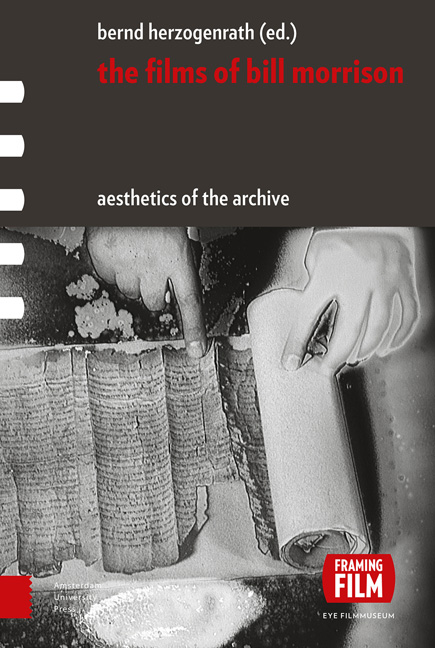Book contents
- Frontmatter
- Contents
- Acknowledgments
- Aesthetics of the Archive: An Introduction
- Chapter 1 Drafts and Fragments: Reflections around Bill Morrison and the Paper Print Collection
- Chapter 2 The Film of Her: The Cine-Poet Laureate of Orphan Films
- Chapter 3 Ghost Trip: Searching for Potential Myths
- Chapter 4 Decasia: The Matter | Image: Film is also a Thing
- Chapter 5 The Mesmerist: Illustrating the Return of the Repressed
- Chapter 6 Light is Calling: Celluloid Dreams
- Chapter 7 Gotham: Zoetrope: Block by Block
- Chapter 8 Outerborough: Early Cinema Revisited
- Chapter 9 The Highwater Trilogy: Thinking the Liquid – On the Ethics of Water and the Material Ecologies of Disaster and Ruination
- Chapter 10 Porch: Archives, Collective Memory, and the Poetics of Home Movies
- Chapter 11 The Future Lasts Long: The Romanov Lost Family Archives
- Chapter 12 Who by Water: Variations on Matter, Figures, Memory, and Mythology
- Chapter 13 Every Stop on the F-Train: Beyond and within the Restless Netherworld of (Manhattan’s) Mind
- Chapter 14 Spark of Being: Bachelor Machine
- Chapter 15 The Miners’ Hymns: Acts of Resurrection
- Chapter 16 Tributes – Pulse: A Requiem for the 20th Century: Death | Drive | Image
- Chapter 17 Just Ancient Loops: The Loops of Life in Intonation
- Chapter 18 The Great Flood: Water is Transparence Derived from the Presence of Everything
- Chapter 19 Re-Awakenings: Bill Morrison in Conversation
- Index of Film Titles
- Index of Names
- Index of Subjects
- Already Published
Chapter 14 - Spark of Being: Bachelor Machine
Published online by Cambridge University Press: 12 December 2020
- Frontmatter
- Contents
- Acknowledgments
- Aesthetics of the Archive: An Introduction
- Chapter 1 Drafts and Fragments: Reflections around Bill Morrison and the Paper Print Collection
- Chapter 2 The Film of Her: The Cine-Poet Laureate of Orphan Films
- Chapter 3 Ghost Trip: Searching for Potential Myths
- Chapter 4 Decasia: The Matter | Image: Film is also a Thing
- Chapter 5 The Mesmerist: Illustrating the Return of the Repressed
- Chapter 6 Light is Calling: Celluloid Dreams
- Chapter 7 Gotham: Zoetrope: Block by Block
- Chapter 8 Outerborough: Early Cinema Revisited
- Chapter 9 The Highwater Trilogy: Thinking the Liquid – On the Ethics of Water and the Material Ecologies of Disaster and Ruination
- Chapter 10 Porch: Archives, Collective Memory, and the Poetics of Home Movies
- Chapter 11 The Future Lasts Long: The Romanov Lost Family Archives
- Chapter 12 Who by Water: Variations on Matter, Figures, Memory, and Mythology
- Chapter 13 Every Stop on the F-Train: Beyond and within the Restless Netherworld of (Manhattan’s) Mind
- Chapter 14 Spark of Being: Bachelor Machine
- Chapter 15 The Miners’ Hymns: Acts of Resurrection
- Chapter 16 Tributes – Pulse: A Requiem for the 20th Century: Death | Drive | Image
- Chapter 17 Just Ancient Loops: The Loops of Life in Intonation
- Chapter 18 The Great Flood: Water is Transparence Derived from the Presence of Everything
- Chapter 19 Re-Awakenings: Bill Morrison in Conversation
- Index of Film Titles
- Index of Names
- Index of Subjects
- Already Published
Summary
ABSTRACT
As Morrison mimics the process of fabrication of the Frankenstein's Creature by ‘stitching together’ footage of heterogeneous origins, this essay aims to produce a meta-discourse on this process by ‘stitching together’ fragments of two short stories by Jorge Luis Borges and notes on an exhibition curated about the concept of ‘bachelor machine’.
These texts displace ‘the monstrous’ toward issues of the circularity of the gaze, the question of who dreamt the dreamer, and the violent obsessions that mark ‘the age of mechanical reproduction’.
Morrison displaces the terrain from the filmic (metaphorical illustrations of a narrative) onto the pro-filmic (the conditions in which the footage was taken and film made), shifting the question of ‘the monstrous’ from the Creature to the cinematic apparatus itself.
KEYWORDS
bachelor machines, mise en abyme, off-screen space, orphan films
We are all the products of these images
Morrison
With relief, with humiliation, with terror, he realized that he, too, was but appearance, that another man was dreaming him.
Borges 1998a, 100
The phrase ‘spark of being’ comes from the Chapter 5 of Mary Shelley's novel, as Victor Frankenstein recounts his story to Captain Robert Walton, whose ship is trapped in the frozen Arctic sea. James Whale's 1931 Boris Karloff vehicle, however, is the version that comes immediately to mind. Renamed Henry, Frankenstein experiments with dead body parts and electricity, and mayhem comes not only from the grotesque shape of his creation, but from human trespass: his assistant Fritz had secured the brain of a criminal. The method used in the novel is more mysterious and no misstep takes place: ‘I collected the instruments of life around me, that I might infuse a spark of being into the lifeless thing that lay at my feet’ (Shelley 2008, 26).
Unlike Whale, Morrison bookends his film with polar sequences, a faithful reflection of the novel's structure. The original narrative is referenced by intertitles separating the different ‘chapters’ (as in silent cinema). Yet, ‘there’s no visible murder, no mayhem […] just some Army footage [in which] they are dragging a corpse off’ (Morrison, 2010).
The Creature, mentioned four times in the titles, seems nowhere to be seen … or is he? Is he the lone sled driver glimpsed at a distance in the midst of a relentless ice field framed by two icebergs? Is he the caped figure standing in the last shot's non-descript landscape?
- Type
- Chapter
- Information
- The Films of Bill MorrisonAesthetics of the Archive, pp. 211 - 226Publisher: Amsterdam University PressPrint publication year: 2017



